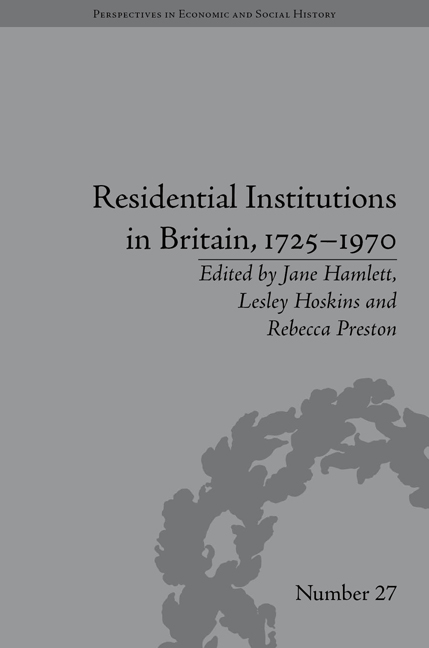Book contents
- Frontmatter
- Contents
- Acknowledgements
- List of Contributors
- List of Figures
- Introduction
- 1 Viewing the Early Twentieth-Century Institutional Interior through the Pages of Living London
- 2 ‘French Beef was Better than Hampstead Beef’: Taste, Treatment and Pauperism in a London Smallpox Hospital, 1871
- 3 From Asylum to Mental Hospital: Gender, Space and the Patient Experience in London County Council Asylums, 1890–1910
- 4 Refuge or Prison? Girls' Experiences of a Home for the ‘Mentally Defective’ in Scotland, 1906–1948
- 5 Paupers and their Experience of a London Workhouse: St Martin-in-the-Fields, 1725–1824
- 6 ‘A Veritable Palace for the Hard-Working Labourer?’ Space, Material Culture and Inmate Experience in London's Rowton Houses, 1892–1918
- 7 ‘The Place was a Home from Home’: Identity and Belonging in the English Cottage Home for Convalescing Psychiatric Patients, 1910–1939
- 8 ‘The Father and Mother of the Place’: Inhabiting London's Public Libraries, 1885–1940
- 9 ‘Discipline with Home-Like Conditions’: The Living Quarters and Daily Life of the Women's Army Auxiliary Corps in First-World-War Britain and France
- 10 Halls of Residence at Britain's Civic Universities, 1870–1970
- Notes
- Index
10 - Halls of Residence at Britain's Civic Universities, 1870–1970
- Frontmatter
- Contents
- Acknowledgements
- List of Contributors
- List of Figures
- Introduction
- 1 Viewing the Early Twentieth-Century Institutional Interior through the Pages of Living London
- 2 ‘French Beef was Better than Hampstead Beef’: Taste, Treatment and Pauperism in a London Smallpox Hospital, 1871
- 3 From Asylum to Mental Hospital: Gender, Space and the Patient Experience in London County Council Asylums, 1890–1910
- 4 Refuge or Prison? Girls' Experiences of a Home for the ‘Mentally Defective’ in Scotland, 1906–1948
- 5 Paupers and their Experience of a London Workhouse: St Martin-in-the-Fields, 1725–1824
- 6 ‘A Veritable Palace for the Hard-Working Labourer?’ Space, Material Culture and Inmate Experience in London's Rowton Houses, 1892–1918
- 7 ‘The Place was a Home from Home’: Identity and Belonging in the English Cottage Home for Convalescing Psychiatric Patients, 1910–1939
- 8 ‘The Father and Mother of the Place’: Inhabiting London's Public Libraries, 1885–1940
- 9 ‘Discipline with Home-Like Conditions’: The Living Quarters and Daily Life of the Women's Army Auxiliary Corps in First-World-War Britain and France
- 10 Halls of Residence at Britain's Civic Universities, 1870–1970
- Notes
- Index
Summary
‘An Essential Part of the Best Kind of University Training’
In 1943, a pseudonymous author calling himself Bruce Truscot published a critique of modern higher education. Entitled Red Brick University, it had an explosive effect on its readers and still influences the terms of debate today. Truscot wrote as an insider – he was actually Edgar Allison Peers, a distinguished professor of Spanish at Liverpool University – and he offered a devastating assessment of what he encountered in his day-to-day work there. He described the other Redbrick professors, exposing them as both underpaid and underworked. He condemned the physical fabric of the modern university, outlining buildings of ‘a hideously cheerful red-brick suggestive of something between a super council-school and a holiday home for children’. And he went on to contrast the student experience at Redbrick with the undergraduate life of Oxford and Cambridge. For Bill Jones of Drabtown – Truscot's archetypical Redbrick student – he had only pity to offer:
Poor Bill Jones! No Hall and Chapel and oak-sporting for him; no invitations to breakfast at the Master's Lodging; no hilarious bump suppers or moonlight strolls in romantic quadrangles; no all-night sittings with a congenial group round his own – his very own – fireplace. No: Bill goes off five mornings a week to Redbrick University exactly as he went to Back Street Council School and Drabtown Municipal Secondary School for Boys – and he goes on his bicycle, to save the two-penny tramfare.
- Type
- Chapter
- Information
- Residential Institutions in Britain, 1725–1970Inmates and Environments, pp. 155 - 166Publisher: Pickering & ChattoFirst published in: 2014

